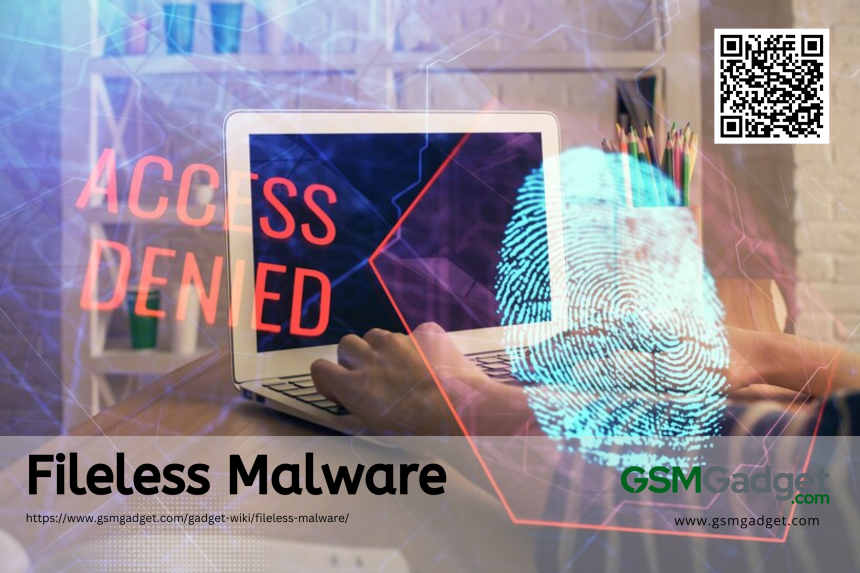Fileless malware is a sophisticated cyber threat that stands apart from traditional malware by not depending on files to breach and persist in a system. It leverages in-memory processes and legitimate system tools on the victim’s computer, executing malicious activities directly in memory and using the operating system’s inherent applications. This allows it to evade detection from antivirus programs that scan for file-based signatures, operating covertly to achieve data theft, system compromise, and maintain persistent control with minimal traces. The stealth and complexity of fileless malware pose a significant challenge to cybersecurity defenses, making it essential to understand its mechanics for developing effective countermeasures against these elusive threats.
Specification Table of Fileless Malware
| Specification | Details |
|
Definition |
Malware that operates without creating or relying on files stored on disk. |
| Infection Vector | Phishing emails, malicious websites, legitimate software vulnerabilities, etc. |
| Persistence Mechanism | Registry keys, WMI subscriptions, scheduled tasks, etc. |
| Common Techniques | PowerShell exploitation, reflective DLL injection, process hollowing, etc. |
| Detection Difficulty | High, due to lack of files on disk and often residing in memory. |
| Primary Targets | System memory, Windows Registry, system and application vulnerabilities. |
| Commonly Affected OS | Windows, though any OS could potentially be targeted. |
| Payload Delivery | Exploits, scripts, code injection, etc. |
| Evasion Techniques | Mimicking legitimate system processes, encryption, obfuscation, etc. |
| Typical Goals | Data theft, espionage, system control, ransomware without files, etc. |
| Forensic Trace | Minimal; may require memory analysis and monitoring of system behavior and network traffic. |
| Removal Complexity | High; may require specialized tools and techniques such as behavior-based detection. |
| Preventive Measures | Endpoint protection solutions, employee training, regular system updates, etc. |
| Notable Examples | APT32’s OceanLotus, Kovter, PowerGhost, etc. |
| Mitigation Strategies | Application whitelisting, disabling unnecessary scripting capabilities, etc. |
| Incident Response | Isolation of affected systems, memory analysis, network monitoring, etc. |
| Potential Impact | Data breach, system downtime, financial loss, reputational damage, etc. |
History of Fileless Malware
The history of fileless malware marks a significant shift in the landscape of cyber threats, with its roots tracing back to the early 2000s and gaining prominence in the early 2010s. Unlike traditional malware, fileless attacks operate within system memory and leverage native tools, such as PowerShell and Windows Management Instrumentation (WMI), to carry out malicious activities without leaving discernible files, thus evading standard detection. Early instances like the Code Red worm in 2001 exploited vulnerabilities to operate without writing to the hard drive. As security measures advanced, so did fileless techniques, incorporating Living off the Land (LotL) strategies to misuse legitimate system functions, complicating detection and analysis. This evolution demonstrates a continual arms race, with cyber adversaries refining their methods to bypass enhanced security, and the cybersecurity industry responding with more sophisticated behavioral and heuristic-based detection strategies to address these elusive threats.
Distinction between fileless malware and traditional malware
Fileless malware marks a departure from traditional malware by leveraging in-memory processes and legitimate system tools to conduct its attacks, avoiding the creation of malicious files on the victim’s storage. This approach results in a minimal footprint, often slipping past conventional antivirus programs that rely on scanning for known malicious files. Traditional malware, on the other hand, depends on the presence of files on the disk for execution, leaving behind detectable traces that security software can target through signature-based detection. The stealthy nature of fileless malware, operating without leaving files on the disk, makes it a particularly challenging threat that can bypass many traditional detection systems, necessitating the use of more sophisticated, behavior-based detection techniques to counteract its elusive tactics.
How fileless malware operates
Fileless malware is a complex cyber threat that utilizes legitimate programs to carry out malicious activities directly in the computer’s memory. Unlike typical malware, it does not leave any files on the hard drive, making it difficult to detect and remove. Below is an outline of the main steps involved in the operation of fileless malware.
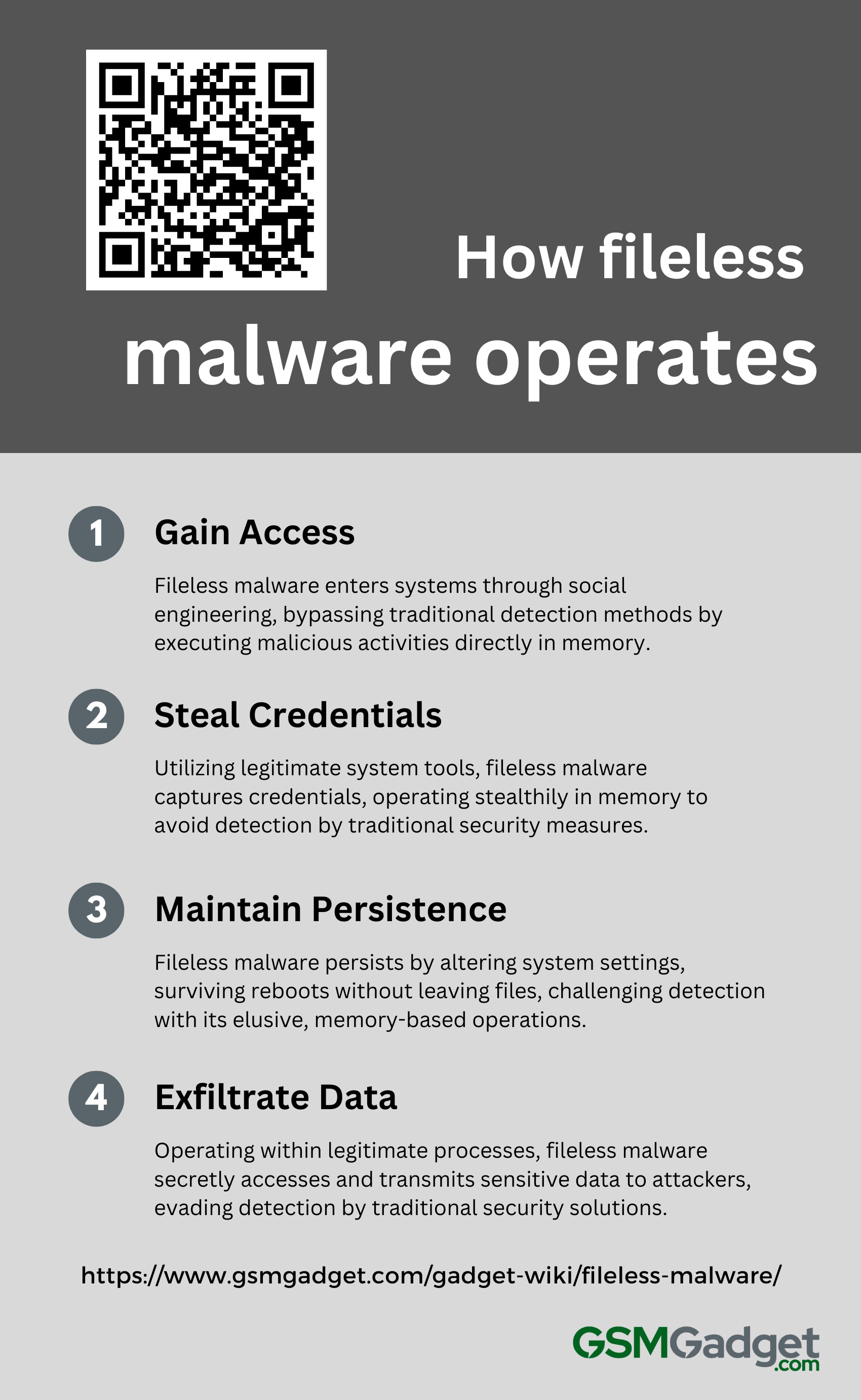
1. Gain Access
Fileless malware represents a stealthy cyber threat that distinguishes itself from traditional malware by not leaving typical traces on a system’s storage. It gains unauthorized entry, often through social engineering like phishing, and then leverages legitimate system tools such as PowerShell or Windows Management Instrumentation (WMI) to run malicious activities directly in memory. This method allows it to stay undetected by standard antivirus programs that search for malicious files. By executing commands and harvesting credentials without writing to the disk, fileless malware maintains a low profile, making detection and removal more challenging. Its ability to move laterally across networks while avoiding security alerts underscores the sophistication of this threat.
2. Steal Credentials
Fileless malware poses a significant cybersecurity threat by executing in-memory attacks to steal credentials, utilizing built-in Windows tools like PowerShell and Windows Management Instrumentation (WMI). This sophisticated malware injects code into legitimate processes, such as web browsers, to capture keystrokes and extract authentication tokens, all without leaving any trace on the hard drive. Its ability to operate within the system’s RAM enables it to bypass many security measures, making detection and prevention particularly difficult. By masquerading as a legitimate user, it can access sensitive data and potentially navigate across networks, maintaining an undetected presence and facilitating further illicit activities. This stealthy and fileless nature of the malware makes it a formidable challenge for both personal and organizational cybersecurity defenses.
3. Maintain Persistence
Fileless malware represents a sophisticated cyber threat that maintains persistence by leveraging native system tools like PowerShell and Windows Management Instrumentation (WMI) to execute malicious activities directly in memory, thereby avoiding traditional file-based detection methods. It achieves persistence by altering registry keys or setting up scheduled tasks, which allows it to survive system reboots without the need to write new files to the disk. This method of operation enables the malware to operate undetected, often circumventing antivirus programs that scan for known file signatures. By operating within the system’s own processes and using the system’s tools for malicious purposes, fileless malware remains a particularly elusive challenge for cybersecurity defenses, as it leaves minimal traces and does not rely on detectable files.
4. Exfiltrate Data
Fileless malware is a sophisticated cyber threat that evades detection by operating within the legitimate processes and memory of a system, rather than writing files to the disk. It uses tools like PowerShell or Windows Management Instrumentation (WMI) to inject malicious code into running processes, enabling it to stealthily access and exfiltrate sensitive data. The malware then transmits the stolen information to an attacker-controlled server, often via encrypted channels to bypass network security measures. By resembling routine network traffic, it avoids raising alarms, allowing attackers to quietly siphon off confidential data and maintain a low profile. This method’s stealthiness makes fileless malware particularly dangerous, as it can carry out its activities undetected by traditional antivirus and endpoint detection solutions.
Common types of Fileless Malware attacks
Fileless malware is a complex cyber threat that utilizes system tools to carry out attacks without creating any files on disk. This malware operates in memory, using legitimate applications and system processes to conduct malicious activities. It is important to be aware of the various types of fileless malware attacks in order to improve cybersecurity measures and prevent potential breaches.
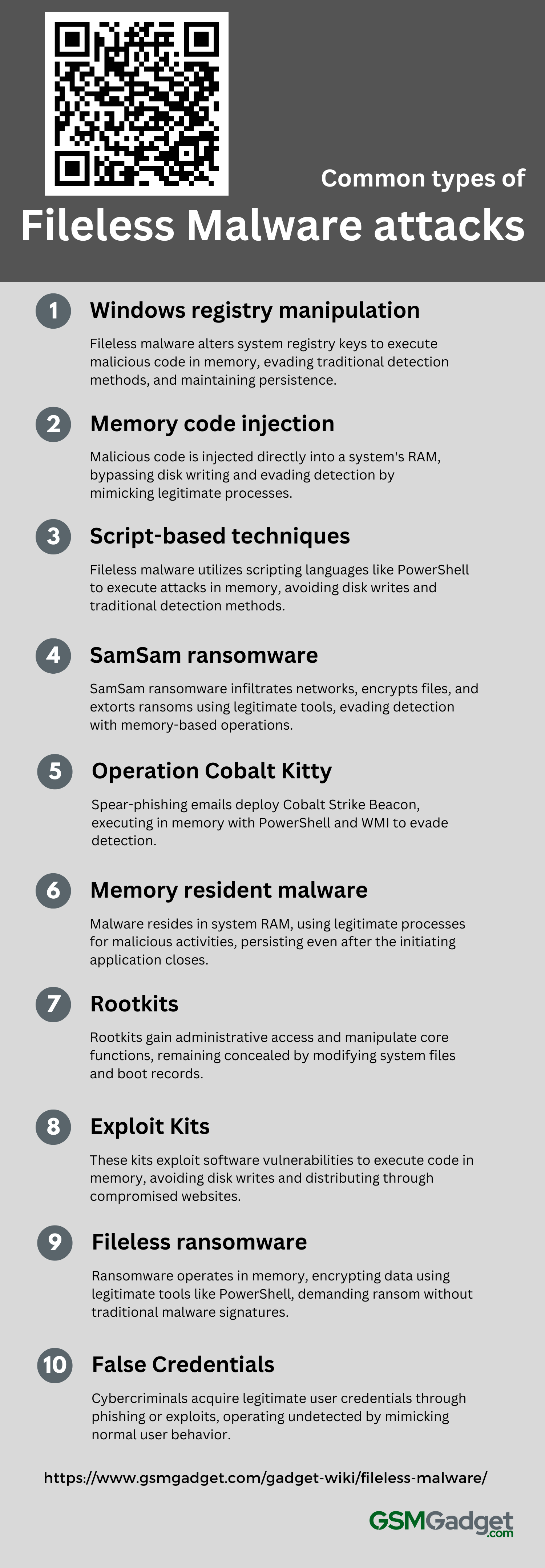
1. Windows registry manipulation
Windows Registry manipulation is a sophisticated fileless malware technique that exploits the registry’s essential role in system configuration to execute malicious code without a disk-based footprint. Attackers insert or alter registry keys to launch harmful payloads in memory during system startup or application launch, bypassing traditional antivirus detection by avoiding disk writing and mimicking legitimate processes. This stealthy approach, which can persist and activate upon startup, poses a challenge for detection and necessitates advanced defenses like behavioral analysis and anomaly detection to effectively counteract the threat. By exploiting the registry, cybercriminals can maintain persistence and control, executing malicious DLLs or scripts with each system boot, all while operating undetected.
2. Memory code injection
Memory code injection is a sophisticated fileless malware tactic where attackers insert malicious code directly into a system’s RAM, skirting the hard disk to avoid detection. This method exploits software vulnerabilities or co-opts legitimate tools to execute within trusted processes, allowing it to carry out insidious actions like data theft, credential harvesting, and maintaining unauthorized access. Because it operates in memory and mimics legitimate activity, it effectively evades standard file-based security protocols. The transient nature of this technique means it leaves few traces, posing a significant challenge for cybersecurity experts in terms of detection and forensic investigation. Consequently, memory code injection represents a stealthy and formidable threat within the landscape of cyber-attacks.
3. Script-based techniques
Fileless malware attacks, particularly those using script-based techniques, have become a significant threat due to their ability to execute malicious activities directly in a system’s memory using trusted scripting languages like PowerShell, JavaScript, and VBScript. These attacks often start via phishing emails or compromised websites and are designed to bypass traditional detection by avoiding disk writes, instead residing in the RAM to exploit vulnerabilities, steal credentials, or gain persistent access. The absence of a conventional malware footprint and the transient nature of memory-resident code make these attacks difficult to detect and analyze, as they can vanish upon system reboot. The stealth and sophistication of such script-based attacks necessitate advanced security solutions capable of identifying and neutralizing threats through behavioral analysis and anomaly detection, rather than relying solely on outdated signature-based methods.
4. SamSam ransomware
SamSam ransomware, emerging in 2016, exemplifies the menacing evolution of fileless malware, exploiting network vulnerabilities to infiltrate organizations without the usual phishing schemes. It stealthily uses legitimate administrative tools to spread, encrypt files, and extort ransoms, often after thorough reconnaissance to ensure maximum disruption. This attack method effectively evades standard antivirus programs by running in-memory and mimicking typical system commands, making it particularly challenging to detect. The insidious nature of SamSam, which demands substantial ransoms, highlights the critical need for advanced security solutions capable of identifying and mitigating threats beyond traditional signature-based approaches.
5. Operation Cobalt Kitty
The Operation Cobalt Kitty campaign, driven by the OceanLotus Group, is a prime example of fileless malware attacks that have increasingly targeted corporations through sophisticated strategies. By exploiting social engineering via spear-phishing emails and deploying Cobalt Strike Beacon through malicious document links and macros, the attackers executed their payloads directly in memory. They utilized legitimate administrative tools like PowerShell and Windows Management Instrumentation (WMI) to remain undetected, as these techniques do not write to the hard drive. This stealthy approach not only bypasses traditional file-based detection but also underscores the necessity for enhanced behavioral detection and proactive threat hunting within cybersecurity defenses to combat such covert and adaptive cyber threats.
6. Memory resident malware
Memory resident malware is a sophisticated fileless cyber threat that embeds itself within a system’s RAM, eluding traditional hard drive scans by antivirus programs. It often gains entry through system vulnerabilities or phishing, then hijacks legitimate processes to conduct its malicious operations discreetly. This malware can manipulate active processes, exfiltrate sensitive data, and introduce further threats, all without leaving a discernible footprint. Its ability to persist in memory even after the initiating application has closed, coupled with tactics like code injection and the exploitation of system tools such as PowerShell and WMI, makes it a particularly insidious and challenging threat to detect. Consequently, combating memory resident malware demands constant vigilance and sophisticated behavioral detection techniques to effectively identify and mitigate these elusive attacks.
7. Rootkits
Rootkits are a formidable type of fileless malware that gain unauthorized root or administrative access to systems, often embedding themselves at the kernel level to manipulate core functions and evade detection by traditional antivirus software. By modifying system files and boot records, they ensure activation before the operating system starts, allowing them to remain concealed and maintain persistent control. These stealthy threats can be introduced through phishing emails or system vulnerabilities and are capable of a range of malicious activities, including keystroke logging, monitoring user behavior, and disabling security measures, making them a particularly dangerous and elusive cybersecurity challenge.
8. Exploit Kits
Exploit Kits (EKs) are a sophisticated category of fileless malware that exploit software vulnerabilities to execute malicious code directly in a system’s memory, avoiding detection by not writing files to disk. These malicious toolkits, which target browsers, applications, and systems, are typically distributed through compromised websites or malvertising and are designed to stealthily probe for unpatched software or security weaknesses. Once a vulnerability is identified, EKs deliver their payload into the computer’s memory, facilitating a range of illicit activities from data theft to ransomware infection. The evolution of EKs to utilize fileless techniques has made them more elusive, representing a significant challenge in cybersecurity and highlighting the importance of constant vigilance and updated protective measures. Renowned EKs like Magnitude, Underminer, and Purple Fox exemplify the ongoing shift towards more sophisticated and harder-to-detect cyber threats.
9. Fileless ransomware
Fileless ransomware is a formidable cyber threat that bypasses conventional detection by using legitimate system tools like PowerShell and Windows Management Instrumentation (WMI) to carry out attacks directly in memory, avoiding the hard drive entirely. These attacks often begin with a phishing campaign or an exploited vulnerability and proceed to use the operating system’s scripting capabilities to encrypt data, subsequently demanding a ransom, typically in cryptocurrency, for the decryption key. The lack of traditional malware signatures renders fileless ransomware difficult to detect, underscoring the importance of advanced security strategies such as behavioral analysis and endpoint protection to monitor and defend against such elusive threats.
10. False Credentials
In the sophisticated landscape of cybersecurity threats, fileless malware attacks that exploit false credentials stand out for their ability to operate undetected, as they don’t leave a conventional footprint on a system’s hard drive. Cybercriminals utilize tactics like phishing, keylogging, and exploiting vulnerabilities to stealthily acquire legitimate user credentials, which they then use to circumvent authentication processes. This grants them the same access privileges as the user they’ve compromised. Such attacks are particularly challenging to identify because they mimic legitimate user behavior, highlighting the necessity for organizations to employ advanced behavioral analytics and multi-factor authentication. By doing so, they can better distinguish between normal user activities and the malicious operations conducted through usurped identities, thereby effectively mitigating these insidious threats.
Tools and techniques for detection of Fileless Malware
In the constantly changing field of cybersecurity, fileless malware poses a particularly dangerous threat by evading traditional detection methods with its stealthy tactics. To address this issue, a variety of advanced tools and techniques have been created to monitor and analyze system behavior, memory, and network traffic for indications of infection. The following are some of the most effective strategies currently utilized to identify and prevent fileless malware attacks:
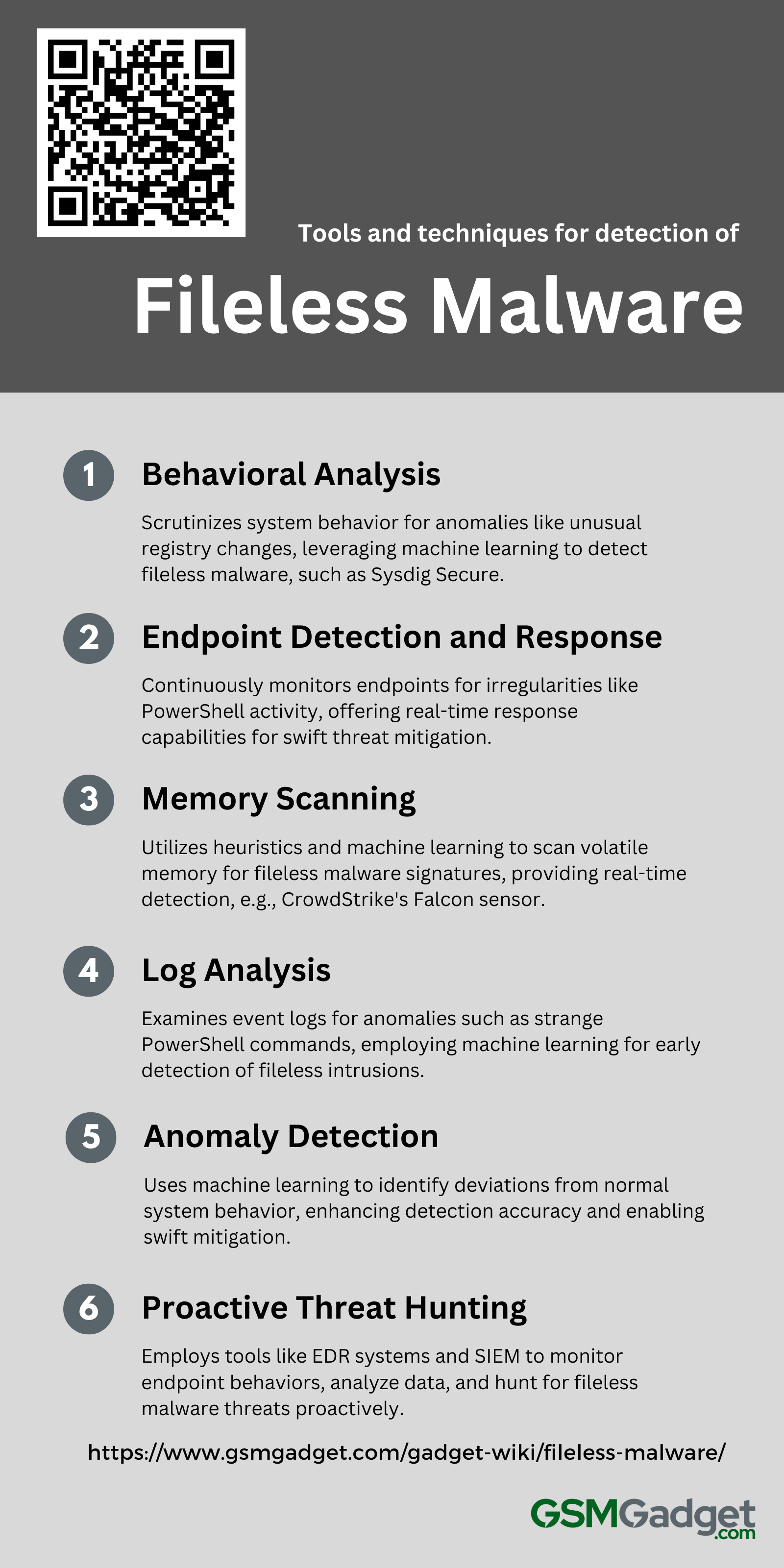
1. Behavioral Analysis
Behavioral analysis is an essential technique for identifying fileless malware, a type of threat that avoids traditional file-based detection by operating directly in memory and manipulating system processes. It scrutinizes system activities to spot deviations from normal behavior, such as atypical registry changes or command executions, which are indicative of such stealthy attacks. Utilizing advanced machine learning algorithms, behavioral analysis tools like Sysdig Secure and Securonix’s platforms continuously learn and adapt to new malware strategies, allowing for the real-time flagging of potential threats. Microsoft’s integration of behavioral monitoring with their Antimalware Scan Interface (AMSI) reflects the industry’s move towards more nuanced, behavior-centric detection methods. These evolving tools are vital in the cybersecurity arsenal, keeping pace with the increasingly prevalent and sophisticated fileless malware.
2. Endpoint Detection and Response (EDR)
Endpoint Detection and Response (EDR) systems are essential for detecting fileless malware, a stealthy cyber threat that traditional antivirus tools often overlook. These systems safeguard endpoints by continuously monitoring and analyzing behavioral data, pinpointing anomalies like irregular PowerShell activity, registry tweaks, and memory-based exploits through advanced analytics and machine learning. EDR’s real-time response capabilities enable security teams to quickly isolate and address threats, conducting thorough investigations and remediations. By focusing on behavioral irregularities and employing complex algorithms, EDR provides a dynamic defense against fileless malware attacks that exploit legitimate system processes to remain undetected and cause harm. This proactive stance is vital for maintaining robust cybersecurity in the face of increasingly sophisticated threats.
3. Memory Scanning
Memory scanning is an essential tool in the arsenal against fileless malware, a type of threat that eludes traditional detection by operating exclusively within a system’s RAM. These advanced tools scrutinize a computer’s volatile memory for anomalies and patterns indicative of such malware, employing a combination of behavioral analysis, heuristics, signature detection, and machine learning algorithms to stay ahead of new threats. Technologies like those in CrowdStrike’s Falcon sensor, which utilize Intel’s Threat Detection Technology, are particularly effective, performing rapid scans of memory to uncover fileless attack signatures and unusual process behaviors. By maintaining vigilant real-time memory monitoring, memory scanning tools provide a vital layer of defense, catching and neutralizing sophisticated attacks that would otherwise remain undetected by conventional antivirus solutions.
4. Log Analysis
Log analysis stands out as an indispensable technique for detecting fileless malware, a stealthy threat that eludes traditional antivirus tools by leaving no files on disk. System and network administrators leverage this method to scrutinize event logs for anomalies such as peculiar PowerShell commands, odd registry changes, and irregular network behavior. Sophisticated log management systems, equipped with machine learning, sift through data to uncover subtle patterns indicative of fileless intrusions, thus safeguarding IT infrastructure integrity. These systems not only analyze logs in real-time but also integrate behavioral heuristics to flag unusual activities, such as unexpected access patterns or strange outbound traffic, offering early detection and facilitating swift countermeasures against these elusive threats.
5. Anomaly Detection
Anomaly detection is a pivotal technique in combating fileless malware, leveraging machine learning and behavioral analytics to identify deviations from normal system behavior in real time. These systems meticulously analyze processes, network traffic, and logs, employing advanced methods like heuristic analysis, artificial intelligence, and data mining to improve accuracy and diminish false positives. By monitoring tools such as PowerShell and WMI for atypical activities, anomaly detection enables security teams to detect and address fileless malware swiftly, bolstering an organization’s defenses against these insidious threats. This proactive stance is crucial for the early detection and mitigation of fileless malware, helping to protect an organization’s digital assets from significant harm.
6. Proactive Threat Hunting
In the fight against the sophisticated and stealthy fileless malware, cybersecurity professionals harness a variety of proactive threat hunting tools and techniques. Advanced Endpoint Detection and Response (EDR) systems, such as Carbon Black and CrowdStrike Falcon, are pivotal in monitoring endpoint behaviors and leveraging machine learning to pinpoint anomalies, while Security Information and Event Management (SIEM) systems aggregate and analyze data to identify potential threats. Behavioral analysis, focusing on deviations from normal network operations, is enhanced by memory scanning tools that examine volatile spaces where fileless malware resides. Forensic tools further dissect scripting languages and in-memory artifacts, and when paired with continuous threat intelligence and stringent incident response protocols, they significantly bolster an organization’s defenses against these elusive cyber threats. This multi-layered approach is essential for detecting and neutralizing fileless malware, which traditional security measures may overlook.
Best practices for prevention of Fileless Malware
Fileless malware presents a distinct challenge as it functions without creating any files on the disk, utilizing legitimate system tools to carry out malicious actions. It is essential to comprehend and deploy strong security measures to protect against these covert threats. The following are key strategies to bolster your system’s ability to withstand fileless malware attacks.
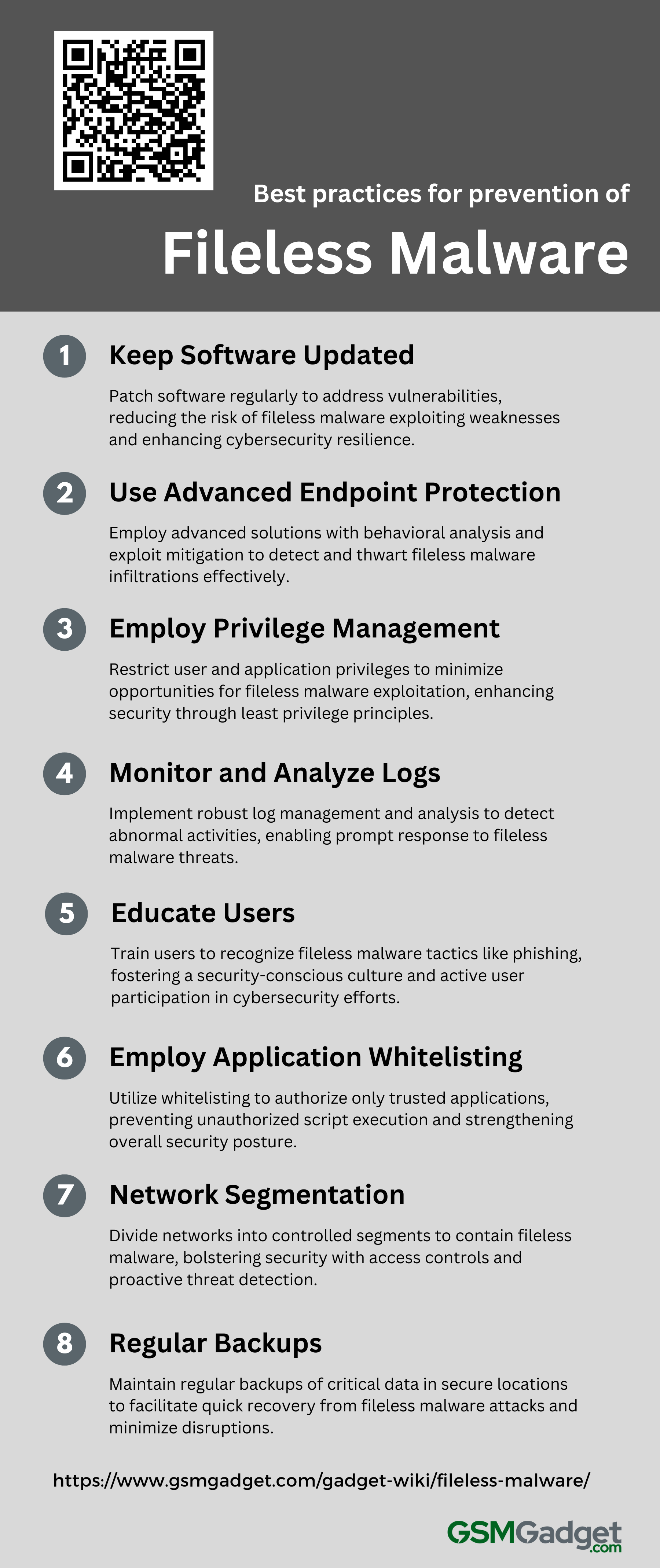
1. Keep Software Updated
Maintaining updated software is a pivotal defense against fileless malware, which capitalizes on vulnerabilities within applications to conduct its malicious operations in memory, eluding standard file-based security measures. It’s crucial to consistently implement software patches and updates, which frequently contain security improvements aimed at sealing the breaches targeted by such malware. Enabling automatic updates, prioritizing patches for critical vulnerabilities, and adhering to a stringent update regimen across all software, including operating systems and firmware, are essential practices. These steps not only embody core cybersecurity hygiene but also act as a proactive barrier against the sophisticated strategies of cybercriminals utilizing fileless tactics, thus significantly shrinking the potential attack surface and reinforcing the security of digital infrastructures.
2. Use Advanced Endpoint Protection
In the dynamic realm of cybersecurity, fileless malware is a particularly stealthy threat that eludes conventional detection by residing in system memory. Advanced endpoint protection is essential to counter this menace, utilizing behavioral analysis, machine learning, and AI to scrutinize system behavior and thwart potential fileless malware intrusions. These solutions are enhanced with exploit mitigation and memory protection to directly combat fileless malware tactics. Features such as application whitelisting, privilege management, and regular updates fortify these systems, closing vulnerabilities and impeding unauthorized actions. Consequently, organizations that keep their endpoint protection up-to-date and maintain vigilant monitoring can effectively shield their digital assets from the elusive perils of fileless malware.
3. Employ Privilege Management
In the battle against fileless malware, robust privilege management is crucial. It acts as a foundation of a strong defense by restricting the opportunities for this type of malware to take advantage of legitimate system tools and applications. By strictly adhering to the principle of least privilege, organizations ensure that both users and applications only have the necessary access rights required for their tasks, thus reducing the potential attack surface. Regular audits and the adjustment of user privileges, in addition to the use of advanced endpoint security solutions that monitor application behavior, are vital components of this strategy. These practices, along with user behavior analytics to detect anomalies that may indicate an attack, enhance the organization’s security posture against the subtle threats posed by fileless malware.
4. Monitor and Analyze Logs
In the battle against fileless malware, it is crucial for organizations to implement a comprehensive log management strategy that focuses on the continuous monitoring and analysis of system, application, and network logs for indications of intrusion. Security Information and Event Management (SIEM) systems play a key role in this endeavor by collecting and applying advanced analytics to log data, identifying abnormal patterns and behaviors that could indicate a security threat. By setting up alerts for unusual activities, such as unexpected use of PowerShell or changes to the registry, IT teams can promptly identify and respond to potential attacks. To stay ahead of cyber adversaries’ evolving tactics, it is important to regularly update detection rules and integrate threat intelligence feeds, which enhance the precision of log analysis and strengthen defenses against these sophisticated and elusive threats.
5. Educate Users
In the battle against fileless malware, user education is crucial. It acts as a primary defense by fostering a culture of awareness and caution within organizations. Regular training sessions are necessary to familiarize users with the latest fileless malware techniques, such as phishing scams, malicious email attachments, and the risks associated with compromised websites. Users need to be able to assess unsolicited communications critically, avoid clicking on unfamiliar links, and promptly report any suspicious activities. It is also important to stress the importance of frequent software updates and the use of advanced endpoint protection tools. These educational initiatives and security measures empower users to actively contribute to enhancing the organization’s overall cybersecurity framework.
6. Employ Application Whitelisting
In the dynamic field of cybersecurity, fileless malware presents a significant threat by evading traditional antivirus tools through executing in memory within legitimate processes. The strategic use of application whitelisting is essential, allowing only approved applications to run and preventing the execution of unauthorized and malicious scripts. This practice not only reduces the potential attack surface but also strengthens the monitoring of application activity, ensuring a strong defense by only running trusted software. Regular updates and maintenance of the whitelist are vital to accommodate new, safe applications and adapt to organizational changes. Ultimately, application whitelisting is a crucial component of a multi-layered security approach, establishing a strong barrier against fileless malware and safeguarding the integrity of enterprise systems.
7. Network Segmentation
Network segmentation is a crucial defense mechanism against fileless malware, a type of threat that utilizes native system tools for malicious purposes while evading detection. By dividing the network into smaller, controlled segments, organizations can effectively monitor and manage internal traffic, thereby preventing the spread of such malware and reducing the overall attack surface. Strong access controls and the principle of least privilege are essential in these segmented zones to restrict unauthorized access and potential exploitation. Diligent monitoring of traffic between segments, coupled with the implementation of advanced security measures such as intrusion detection systems, bolsters the network’s security by offering greater visibility and proactive threat detection. Together, these practices are essential for mitigating the risks associated with fileless malware and protecting network resources.
8. Regular Backups
In the field of cybersecurity, the stealthy nature of fileless malware requires a strong defense strategy, with regular backups serving as a key component. By consistently backing up important data to secure, isolated locations such as cloud storage or separate physical devices, organizations can ensure data integrity and quickly recover from an attack, minimizing operational disruptions and financial losses. These backups should be performed regularly, checked for integrity, and kept separate from the main network to prevent potential contamination. Implementing a comprehensive backup plan, along with ongoing employee training, timely software updates, and multiple layers of security measures, enables organizations to effectively combat the elusive threats posed by fileless malware and maintain a strong cybersecurity posture.
